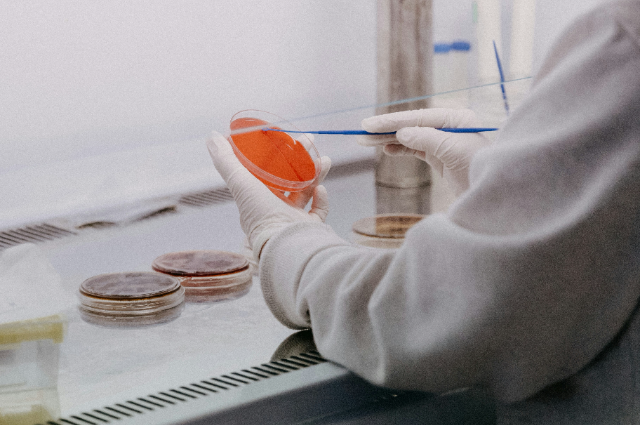
Photo by Trnava University on Unsplash
Living cells are surrounded by a delicate and highly flexible membrane which is essential for various biological processes. This membrane plays a key role in the cell’s ability to protect and repair itself when damaged. However, the detailed mechanisms behind this process are still not fully understood.
The Role of Cryo-Electron Microscopy
Researchers at Forschungszentrum Jülich have recently made steps in exploring this area by using advanced cryo-electron microscopy. Through this technology, they uncovered fascinating new details about how the cell membrane may reinforce itself when necessary. Specifically, they studied a membrane protein known as Vipp1, commonly found in the photosynthetic systems of plants, algae and certain bacteria. Vipp1 seems to create various structural forms that can be employed to fortify the cell membrane during times of stress or damage.
Investigating Bacterial Protein PspA
In further studies, the research team also examined the bacterial protein PspA, which is closely linked to Vipp1. Both Vipp1 and PspA exhibit remarkable flexibility by enabling them to adopt multiple shapes such as rings and tubes with different sizes. This flexibility suggests that these proteins play a crucial role in maintaining the integrity and function of the cell membrane across different environments. The findings highlight the complex and adaptive nature of the cell’s repair mechanisms by offering new perspectives on how cells might protect themselves in challenging conditions.
The Vital Role of the Cell Membrane
The cell membrane serves a multitude of essential functions that are crucial for cellular integrity and communication.
Protective Barrier and Nutrient Gateway
Primarily, it acts as a protective barrier by safeguarding the internal components of the cell from external environmental threats. This thin yet resilient layer not only shields the cell but also facilitates the absorption of vital nutrients. Simultaneously, it plays a key role in eliminating waste products by ensuring that the cellular environment remains balanced and functional. Moreover, the membrane is integral to communication between cells as transmitting signals that are vital for coordinating various biological processes.
Sensitivity to Environmental Stressors
Despite its protective capabilities, the cell membrane is remarkably sensitive. Composed of a delicate lipid bilayer, it can be vulnerable to various forms of stress including physical pressure and stretching. Chemical influences also pose a risk to its integrity. Environmental factors such as ultraviolet (UV) radiation and toxic substances can inflict significant damage on this crucial structure.
Impact on Plant Cells
In plant cells, the stakes are particularly high. For instance, intense light exposure can place considerable stress on the membranes found within chloroplasts—the sites of photosynthesis. This stress can lead to severe damage by threatening the plant's ability to perform essential functions. To combat these challenges, certain proteins such as Vipp1 have become indispensable. These proteins not only help protect the membrane structures but also play a critical role in repairing them when necessary. While the cell membrane is fundamental to cellular function and protection, its sensitivity to external factors necessitates robust mechanisms for maintenance and repair to ensure cell survival and efficiency.
Unravelling the Secrets of Vipp1 and Cell Membrane Interaction
Recent advancements in cryo-electron microscopy at Jülich's Ernst Ruska Centre have illuminated the intricate relationship between the protein Vipp1 and cell membranes by revealing mechanisms critical for cellular stability and repair.
The Role of Vipp1 in Membrane Stability
Vipp1, a vital protein found in the chloroplasts of plants and algae has been shown to form unique carpet-like structures on the cell membrane. This arrangement not only stabilizes the membrane but also plays a crucial role in its maintenance. Researchers have discovered that Vipp1 can assemble into ring complexes and tubular formations that are filled with membrane material. These structures may serve multiple purposes as they can potentially "pinch off" damaged areas of the membrane and facilitate connections between separate membranes, thereby enhancing cellular integrity.
Insights from Cutting-Edge Technology
The use of state-of-the-art cryo-electron microscopes has allowed scientists to observe Vipp1 in unprecedented detail. This technology provides atomic-resolution images that reveal various structural states of Vipp1 as it interacts with membranes. Such insights are pivotal for understanding how cells protect themselves from environmental stressors, including UV radiation and chemical damage, which can compromise membrane integrity.
Comparative Mechanisms with ESCRT-III Proteins
Interestingly, the mechanisms observed in Vipp1 are strikingly similar to those of ESCRT-III proteins found in human cells. These proteins are known for their conserved roles across evolution by suggesting that the fundamental processes governing membrane remodelling and repair are crucial for all life forms. Understanding these similarities could pave the way for innovative biotechnological applications including the development of new antibiotics targeting cellular membrane processes.
Potential Biotechnological Applications
The implications of these findings extend beyond basic science. By deepening our understanding of how Vipp1 and PspA interact with cell membranes, researchers could pave the way for innovative biotechnological applications. For instance, insights gained from these proteins could lead to the development of new drugs such as antibiotics that specifically target membrane processes by enhancing our ability to combat bacterial infections.
Future Directions in Research
As research continues to unfold around Vipp1 and PspA, it is crucial to explore their structural and functional dynamics further. Advanced imaging techniques like cryo-electron microscopy have already provided valuable insights into their interactions with membranes at an atomic level. Continued investigation will not only clarify their roles in cellular health but may also inspire novel approaches to engineering biomaterials or optimizing agricultural practices through enhanced photosynthesis.
The recent findings on Vipp1 and PspA illuminate their vital roles in membrane dynamics and cellular protection. As we deepen our understanding of these proteins, we stand on the brink of exciting new developments that could transform both medicine and agriculture.
. . .
References:
